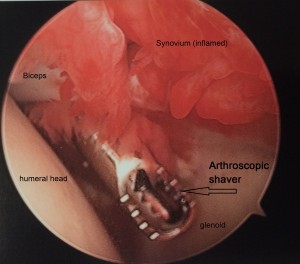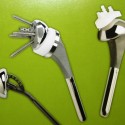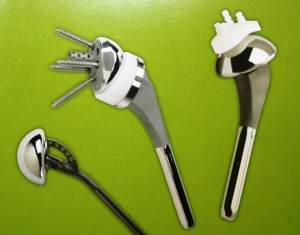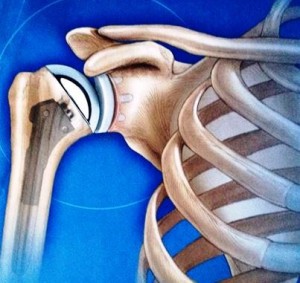Shoulder Surgery
Shoulder Surgery is now very common, because it is much more successful now with less invasive modern techniques. The shoulder is the most mobile joint in the human body. This mobility is provided by the many muscles-including the rotator cuff surrounding the shoulder joint working in concert.
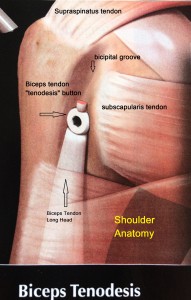
The shoulder joint has a very shallow bony socket, which means that keeping the shoulder stable is also primarily the job of the soft tissues (including the rotator cuff) surrounding the shoulder. The soft tissues surrounding the shoulder allow for a well coordinated range of movement which includes rotation and gliding of the shoulder ball and socket joint and the shoulder blade.
Shoulder Replacement
When the normally smooth surface of the shoulder joint becomes rough and painful-as with shoulder arthritis – shoulder surgery and a total shoulder replacement can restore the smooth surface, providing much needed pain relief. The soft tissues surrounding the shoulder are then able to resume their work in providing a well coordinated range of movement and function.
Total shoulder replacement, or shoulder arthroplasty, is the replacement of the ball of the upper arm and socket of the shoulder blade with specially designed artificial implants (also called prostheses) made of metal and polyethylene (a medicalgrade plastic). The humeral (upper arm) component consists of a metal ball that replaces the head of the humerus, and a stem that is secured into the upper arm bone. The glenoid (shoulder blade socket) prosthesis is made of a special polyethylene and is designed to replace the socket or cup part of the joint and is often secured with bone cement.
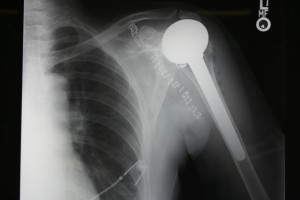
The metal ball and stem units are selected by your surgeon from multiple sizes to fit the contour and shape of your humerus. This two-piece construction is known as a modular prosthesis. This allows precision fitting of the ball and socket to your shoulder, which enhances the proper repair and tension of the muscles around the joint. Read more about shoulder replacement here: https://www.facebook.com/shoulderreplacement
Reverse Shoulder Replacement
Sometimes shoulder arthritis can coexist or be the result of an unstable shoulder. One reason for this can be a large rotator cuff tear that cannot be repaired leading to a high riding shoulder joint. A standard shoulder replacement addresses the arthritis but doesn’t answers the problem of a high riding or unstable shoulder. Note that in a standard shoulder replacement the shoulder hosts the “socket” and the arm has the “ball”.
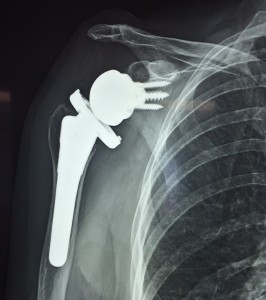
A reverse total shoulder replacement helps experienced shoulder surgeons provide an answer for the debilitating shoulder pain due to this combination of arthritis and instability. Note that we “reverse” the ball to the shoulder and the socket to the arm, which gives the procedure its name, the Reverse Total Shoulder Replacement. The reverse total shoulder replacement provides the shoulder with a stable center of rotation allowing the muscles of the shoulder to resume their optimal length. As it is a type of total shoulder replacement, it replaces the arthritic and painful joint as well. This combination of stability and pain relief can provide patients with improved range of motion and function. Read more about reverse shoulder replacement at www.facebook.com/shoulderreplacement
Shoulder Surgery : Rotator Cuff Repair
The shoulder joint frequently wears out in active individuals. In many cases, the muscles that move the shoulder are torn or damaged. Dr. Kozinn can repair your rotator cuff using arthroscopic or open techniques. Rotator Cuff surgery is most often done as an outpatient procedure and the results are usually excellent allowing active patients to enjoy their favorite activities. Dr. Kozinn was trained at the world famous Hospital For Special Surgery, where he was taught by the greatest shoulder surgeons to fix rotator cuffs arthroscopically and open.
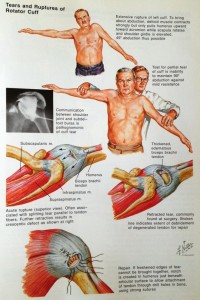
Typically patients go home the same day and can now use their arm for simple chores on the first day after surgery. We let you drive your car immediately, as long as you are safe, and have full control of the vehicle. Often there is very little pain, as the repair is done through tiny holes called portals. Therefore no pain from muscle detachment. That is the big reason to avoid an open repair if possible, taking the deltoid muscle off the acromion can be quite painful, and the repair needs to be protected.
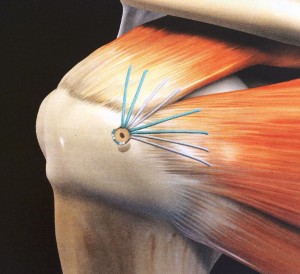
Rotator cuff tears are a common source of shoulder pain. The incidence of rotator cuff damage increases with age and is most frequently caused by degeneration of the tendon, rather than injury from sports or trauma. Although the information that follows can be used as a guide for all types of rotator cuff tears, it is intended specifically for patients with complete degenerative tears of the rotator cuff. Often we try an injection of cortisone before going to the operating room. Sometimes physical therapy can help reduce the symptoms from a torn cuff.
Depending on age and medical health, treatment recommendations vary from rehabilitation (PT) to surgical repair of the torn tendon(s). The best method of treatment is different for every patient. Most will opt to have an arthroscopic repair because it has the fastest recovery and the least pain. The final decision on how to treat rotator cuff tears is based on the patient’s severity of symptoms, functional requirements, and presence of other illnesses that may complicate treatment.
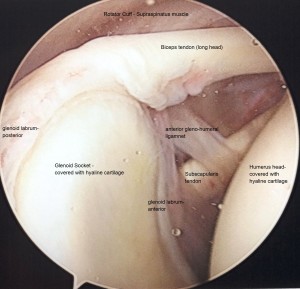
Shoulder Instability
The shoulder is the most moveable joint in your body. It helps you lift your arm, rotate it, and reach up over your head. It is able to turn in many directions. This greater range of motion, however, results in less stability. Shoulder instability occurs when the head of the upper arm bone is forced out of the shoulder socket. This can happen as a result of a sudden injury or from overuse. Once a shoulder has dislocated, it is vulnerable to repeat episodes. When the shoulder is loose and slips out of place repeatedly, it is called chronic shoulder instability.
Chronic shoulder instability is often first treated with nonsurgical options. If these options do not relieve the pain and instability, surgery may be needed to repair torn or stretched ligaments so that they are better able to hold the shoulder joint in place.
The type of surgery will vary depending on each each patient’s unique needs. In most cases, the procedure can be performed arthroscopically using tiny instruments and small incision; this is a same-day or outpatient procedure. However, some patients may need an open surgical procedure. This involves making a larger incision over the shoulder and performing the repair under direct visualization.
